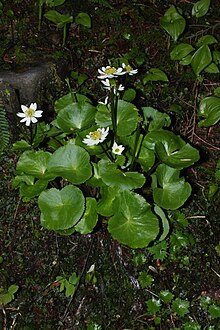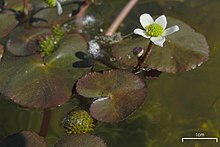Marigolds
| Marigolds | ||||||||||||
|---|---|---|---|---|---|---|---|---|---|---|---|---|

Marsh marigold ( Caltha palustris ) |
||||||||||||
| Systematics | ||||||||||||
|
||||||||||||
| Scientific name | ||||||||||||
| Caltha | ||||||||||||
| L. |
The marigolds ( Caltha ) are a genus of plants from the buttercup family (Ranunculaceae). Ten species from the temperate zones of both hemispheres belong to this genus. The name Caltha can be etymologically derived from the Greek term for calyx ( kályx ).
description
Marigold species are perennial, herbaceous plants . They form rhizomes as persistence organs. All parts of the plant are bare. The alternate leaves are simple and heart-shaped. In some species a bent appendix is formed from the auricles of the leaf blade . Stipules are missing.
The flowers are single or few in zymose inflorescences. The hermaphroditic flowers are radial symmetry . The perianth consists of a single circle of five or more petal-like , golden yellow or white sepals . The 15 to 25 stamens are shorter than the sepals. The four to fifteen free and upper carpels are several upright together. Each carpel contains several ovules in two rows. The hairless follicles stand together in several.



Occurrence
The genus prefers cooler areas and is found in the temperate and cold regions of the northern and southern hemisphere , with only limited occurrences in the southern hemisphere, which is probably due to the lack of suitable locations. All species of the genus prefer moist locations. At lower altitudes the genus is bound to swamps and other wetlands, at higher altitudes it is often associated with meltwater. There are two types in Australia.
Systematics
The genus Caltha is divided into two sections based on morphological and geographical differences with a total of ten species. Section Psychrophyla is common in six species in the southern hemisphere and has bent appendages on the leaves; the section Caltha with four species is widespread in the northern hemisphere and does not form any leaf appendages. This division of the genus was confirmed by molecular biological studies.
- Section of Caltha
- West American marigold ( Caltha leptosepala DC. ), Native to: Alaska, Western Canada, Western USA, Rocky Mountains
- Floating marigold ( Caltha natans Pall. ), Native to: Northern Asia, Alaska, Canada, Minnesota, Wisconsin
- Marsh marigold ( Caltha palustris L. ), origin: Europe, Asia, North America
- Caltha scaposa Hook. f. & Thomson , home: Himalaya
- Section Psychrophila DC. (Some authors put the species in their own genus Psychrophila (DC.) Bercht. & J. Presl )
- Caltha appendiculata Pers. , Home: Argentina
- Caltha dionaeifolia Hook. , Home: Argentina
- Caltha introloba F. Muell. , Home: Australia
- Caltha novae-zelandiae Hook. f. , Home: New Zealand
- Caltha obtusa Cheeseman , home: New Zealand
- Caltha sagittata Cav. (Syn .: Psychrophila sagittata (Cav.) Bercht. & J. Presl ), home: southern tip of South America
swell
- L. Villar: Caltha. In: Flora Iberica. Plantas vasculares de la Península Ibérica e Islas Baleares, Volume I - Lycopodiaceae - Papaveraceae. 1986, ISBN 84-00-06222-1 , pp. 231-233.
- Eric Schuettpelz, Sara B. Hoot: Phylogeny and biogeography of Caltha (Ranunculaceae) based on chloroplast and nuclear DNA sequences . In: American Journal of Botany. Volume 91, Number 2, 2004. pp. 247-253.
- Walter Erhardt among others: The big pikeperch. Encyclopedia of Plant Names . Volume 2. Verlag Eugen Ulmer, Stuttgart 2008. ISBN 978-3-8001-5406-7
